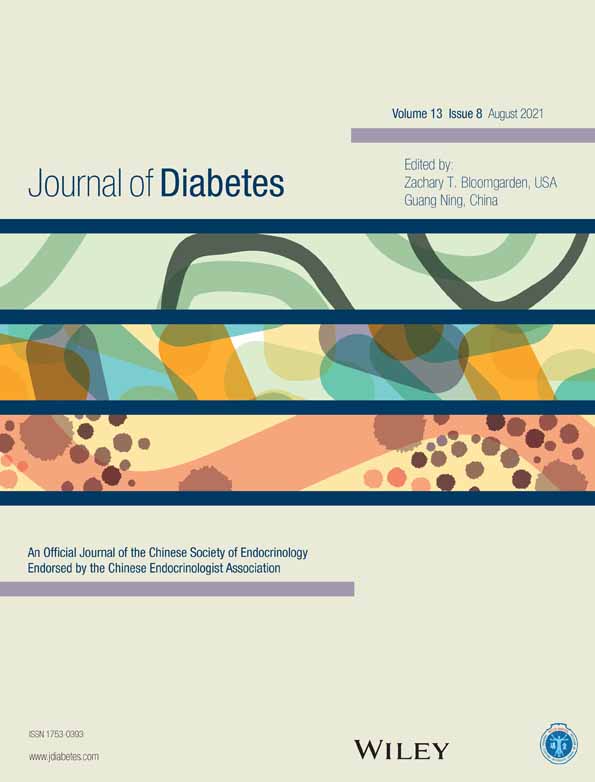Type 2 diabetes in the young in South Asia: Clinical heterogeneity and need for aggressive public health measures
南亚年轻人中的2型糖尿病:临床异质性以及采取积极公共卫生措施的必要性
One of the hotspots of diabetes in the world is South Asia, which currently has 88 million people with diabetes, 77 million of whom live in India.1 Type 2 diabetes (T2D) in South Asians exhibits a number of characteristic features including high magnitude of insulin resistance and rapid decline in beta cell function, with diabetes occurring at lower threshold for body mass index (BMI) than in European and North American populations.2-7 This ethnic group shows low muscle mass, increased intra-abdominal adiposity, excess hepatic fat, and the characteristic dyslipidemia (low high-density lipoprotein [HDL] cholesterol and high triglycerides). This “South Asian Phenotype” makes them more prone to develop hyperglycemia and cardiovascular disease at a relatively young age, a feature that has been seen in other ethnic groups as well (eg, Chinese). In young South Asians with diabetes diagnosed below 30 years of age, an intriguing array of other diabetes phenotypes is seen including type 1 diabetes (T1D), maturity onset diabetes of the young, and a tropical variety of diabetes known as fibrocalculous pancreatic diabetes6 but these will not be discussed further.
There are increasing data to suggest an emerging epidemic of youth-onset T2D in India and South Asia, in parallel with the increase in childhood obesity.8 In the South Indian state of Tamil Nadu, among persons age 25-34 in large cities, smaller towns, and peri-urban villages, the prevalence of diabetes in 2006 and 2016 increased from 5.3% to 10.4%, from 1.8% to 6.3%, and from 3% to 5.9%, respectively, whereas the prevalence of prediabetes increased from 10.4% to 17.2%, from 2.8% to 17.2%, and from 5.9% to 11.4%, respectively.9 These levels are higher than those in India as a whole, with a 15-state stratified sampling study showing an overall prevalence at ages 25 to 34 around 2%,10 similar to global diabetes estimates for this age group.11 Looked at in another fashion, analyzing data from cohorts in Delhi and Chennai, approximately 5% of men and women of low or normal weight (BMI < 23 kg/m2), 8% and 6% of males and females with BMI kg/m2 ≥ 23 to <27.5, and 10% and 8% of males and females with BMI≥27.5 kg/m2 develop diabetes from ages 20 to 39.12 The characteristic features in these young patients with diabetes include strong family history of T2D (usually in both parents), abdominal obesity, and hypertriglyceridemia with very low HDL-cholesterol levels.13, 14 Even nonobese/lean young patients with T2D have insulin resistance15, 16 and high glucagon levels.17 Greater insulin secretory deficiency may be a particular feature of South Asian populations, further increasing diabetes risk. 18-20 Interestingly, even in the group of nonobese patients, excess fat (abdominal, hepatic) appears to play an important contributory role for the metabolic perturbations observed.21 In addition, recent research has shown different clusters of T2D among south Asians.22 Three of these, severe insulin deficient diabetes (SIDD), insulin resistant obese diabetes (IROD) and combined insulin resistant and deficient diabetes (CIRDD) occur at younger age groups and two of them IROD and CIRDD are novel subtypes described for the first time in this ethnic group.22 The treatment for these subtypes varies. The SIDD variety appears to be the most difficult to treat and may need early insulin therapy. They are also more prone to some complications including retinopathy and neuropathy. The IROD variety is associated with obesity, severe insulin resistance and would be expected to respond better to an insulin sensitizer like metformin. These patients are more prone to nephropathy and cardiovascular disease. Finally, the CIRDD variety have the highest serum triglyceride and lowest HDL-cholesterol levels and they are prone to both retinopathy and nephropathy. These patients may require both an insulin secretagogue and an insulin sensitizer to obtain good metabolic control.
The main challenge today is to halt or slow down the twin epidemics of obesity and T2D. Increasing obesity-related T2D will increasingly pose hurdles to India's public health delivery as nutrition and lifestyle transitions shift the obesity and diabetes epidemic to the poorer sections of society.10, 23 Proliferation of restaurants offering quick fast-food delivery and decrease in physical activity (even before the COVID-19 pandemic) are issues that need urgent and extensive public education and awareness programs. The pandemic has posed additional challenges in the young, with weight gain due to low physical activity and dietary indiscretion, thus further increasing risk for diabetes.24 As the COVID-19 pandemic intensifies, noncommunicable diseases like obesity, CVD and T2D tend to be ignored. The latter are responsible for far greater morbidity and mortality than COVID-19 and add to its morbidity and mortality.
It is encouraging to note that a structured school-based multicomponent model of nutrition and lifestyle interventions has shown several benefits in urban Asian Indian adolescents: positive behavior modification, loss of weight, and increased insulin sensitivity.25 Balanced diets and maintenance of regular physical activity through combined initiatives of parents, school teachers, and doctors are key strategies to address obesity and diabetes in young people.26, 27 Enhanced endeavors are needed during these times.
南亚是世界上糖尿病的高发地之一, 目前有8800万糖尿病患者, 其中7700万生活在印度。南亚人的2型糖尿病(T2D)表现出许多特征, 包括胰岛素抵抗程度高、β细胞功能迅速下降, 以及相对于欧洲和北美人群, 南亚的糖尿病发生在体重指数(BMI)阈值较低的情况下。这一民族表现为肌肉量低、腹内肥胖症增加、肝脏脂肪过剩, 以及特征性的血脂异常(低或者高)。这种“南亚表型”使他们在相对年轻的时候更容易患上高血糖和心血管疾病, 这一特征在其他民族(如中国人)中也可以看到。在被诊断为30岁以下糖尿病的南亚年轻人中, 发现了一系列耐人寻味的其他糖尿病表型, 包括1型糖尿病(T1D)、青春期发作性糖尿病, 以及一种被称为纤维结石性胰腺糖尿病的热带糖尿病, 但这些不会进一步讨论。
在南印度泰米尔纳德邦, 在大城市、小城镇和城郊村庄的25-34岁人群中, 2006年和2016年糖尿病的患病率分别从5.3%上升到10.4%, 从1.8%上升到6.3%, 从3%上升到5.9%, 而糖尿病前期的患病率从10.4%上升到17.2%, 从2.8%上升到17%。这些水平高于印度的整体水平, 15个邦的分层抽样研究显示, 25岁至34岁的总体患病率约为2%, 与全球对这一年龄段的糖尿病估计值相似。以另一种方式看, 分析来自德里和金奈的队列数据, 大约5%的属于低体重或正常体重(体重指数<23 kg/m2)男性和女性、体重指数为23~27.5 kg/m2的8%的男性和6%的女性、体重指数大于27.5 kg/m2的10%男性和8%的女性在20岁到39.12岁之间会发展为糖尿病。这些年轻糖尿病患者的特征包括高度相关的T2D家族史(通常双亲都有), 腹型肥胖, 以及非常低胆固醇水平的高甘油三酯血症。即使是非肥胖/瘦的T2D年轻患者也有胰岛素抵抗和高胰高血糖素水平。胰岛素分泌不足可能是南亚人群的一个特殊特征, 进一步增加了糖尿病的风险。最近的研究表明南亚人中存在不同的T2D聚集性。其中三个亚型, 严重胰岛素缺乏性糖尿病(SIDD)、胰岛素抵抗肥胖糖尿病(IROD)和胰岛素抵抗与缺乏糖尿病(CIRDD)发生在较年轻的人群中, 其中IROD和CIRDD是首次在该民族中描述的新亚型。这些亚型的治疗方法各不相同。各种类型的SIDD似乎是最难治疗的, 可能需要早期胰岛素治疗。他们也更容易出现一些并发症, 包括视网膜病变和神经病变。IROD的变化与肥胖、严重的胰岛素抵抗有关, 预计对二甲双胍等胰岛素增敏剂的反应会更好。这些患者更容易患肾病和心血管疾病。最后, CIRDD变种具有最高的血清甘油三酯和最低的HDL-胆固醇水平, 他们容易患视网膜病变和肾病。这些患者可能同时需要胰岛素促分泌剂和胰岛素增敏剂才能获得良好的代谢控制。
今天的主要挑战是阻止或减缓肥胖症和T2D的双重流行。随着营养和生活方式的转变,肥胖症和糖尿病的流行将转移到较贫穷的社会阶层, 与肥胖相关的T2D的增加将越来越多地对印度的公共卫生服务构成障碍。提供快餐的餐馆激增以及体力活动减少(甚至在新型冠状病毒肺炎大流行之前)是需要紧急和广泛地被认知的公共教育问题。这一流行病给年轻人带来了额外的挑战, 由于缺乏体力活动和饮食不检点导致体重增加, 从而进一步增加了患糖尿病的风险。随着新型冠状病毒肺炎大流行的加剧, 肥胖症、心血管疾病和糖尿病等非传染性疾病往往被忽视。后者导致的发病率和死亡率比新型冠状病毒肺炎高得多, 并增加了它的发病率和死亡率。
令人鼓舞的是, 以学校为基础的营养和生活方式干预的结构化模式在城市亚裔印度青少年中显示了几个好处:积极的行为纠正、体重减轻和胰岛素敏感性增加。通过家长、学校教师和医生的联合倡议, 平衡饮食和保持定期体育活动是解决年轻人肥胖和糖尿病的关键战略。




